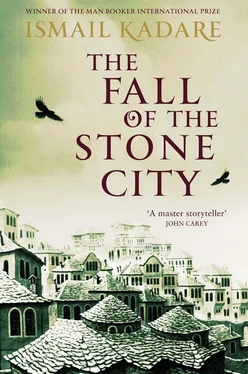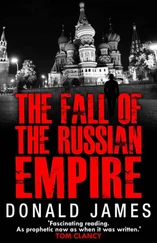Whenever governments turned nasty they used this cave as a threat, but people were sure that it would never be put to use again. So in that unforgettable February when there was talk of the Cave of Sanisha being opened, something else was in fact expected, perhaps the release of the two doctors. Everybody felt sure that they had been arrested in error. When the news came one evening that not only had their arrest been no mistake, but that after one hundred and fifty years of disuse the Cave of Sanisha would be their dungeon, the city was incredulous. The cave had not been opened after the murder of the Turkish prefect nor the suspected murder of the sultan’s mother, the rebellion against the king nor even the conspiracy of the anti-communist members of parliament; but now it was to be used for the doctors.
The report turned out to be true. The cave had been specially equipped for them, and both the doctors were already inside it.
What condition were they in? Did they rest their heads on stones for pillows, did anyone think to cover them with blankets? Both Gurametos, wasting in prison! Were they chained to the wall like the rapists of long ago? Was salt rubbed into the wounds of their tortured bodies? Or were they well treated with champagne and music?
All sorts of strange questions were asked before anybody thought of the most important one: what had they done?
At first it was hard to find anything to accuse them of but soon it became easy enough. Just as the world was swept with wind and rain, so it was burdened with guilt. A share could be allotted to the doctors with plenty left over for others.
Meanwhile these frantic attempts to conjure up a crime were interrupted by the arrival of two investigators. Shaqo Mezini and Arian Ciu were two young men from the city, fresh graduates of the Dzerzhinsky Academy of the secret police in Moscow. Their faces were pale, their ties tightly knotted and their overcoats extremely long. The godfather of the secret police who gave his name to the academy had proverbially worn a coat like this and had said, “Long coat, short shrift.”
The two investigators became the visible dimension of the Gurameto case. The doctors were below in the dark of the pit but at least the investigators bobbed above the surface like balloons, signals from the lower depths.
On Tuesday, 13 February, the two investigators emerged from the Cave of Sanisha clutching their files and strode purposefully down Hamurati Street, heading not for the police station but the hospital.
Remzi Kadare was at the gate, his expression menacing and his face distorted with senseless fury. He wagged his finger. “Whatever happens here isn’t my fault. If you want to find the guilty ones, look at the other Kadares from Palorto.” He lowered his voice. “Oh no, what’s going on? They’re up to no good.”
The investigators listened in puzzlement and then crossed the hospital yard, watched by the doctors and nurses standing at the entrance.
The examination of the two doctors’ operation records, or rather, the full list of their patients, caused no concern. On the contrary, a wave of relief swept through the entire hospital. This first ray of light shed on the mystery roused some hope. They were looking at the mortality rate of operations. Everywhere in the world people died during surgery, their families complained about the doctors, the doctors justified themselves and the cases went to court.
The investigators spent more than four hours in the hospital registry. Before they had passed the main gate, where Remzi Kadare again stood ready to say something that to him was very important, the first results of the investigation became known. Of the twelve thousand and more operations carried out by Big Dr Gurameto, about one thousand eight hundred patients had died on the operating table or soon after. The number for Little Dr Gurameto was less than one thousand. (The tendency to compare the two was again apparent.)
The investigation of the two doctors, like many things where they were concerned, took place on two levels. The first, in the Cave of Sanisha, was hidden from everybody. The second and visible dimension involved the hospital, the morgue, family homes and sometimes the cemetery. Records of autopsies and personal interviews were attached to the medical records.
The investigators, now pale after sleepless nights, appeared less often in the city. They lost weight, making their overcoats seem even longer. What was called the public side of the investigation now had its own secret aspects, which strangely did not relate to the dead but to the living. One by one, surviving patients, or rather their surgical scars, were to be examined for the oddest things, such as stitches in the form of six-pointed stars, tattoos, and old symbols (Hebrew ones for instance) of mysterious import.
Some called these stories crazy but others replied, “Wait, just wait and you’ll see. This business will go far. This is serious stuff.” Since the two doctors were not only surgeons but gynaecologists, women would also be subjected to intimate examinations.
Listeners to foreign radio stations, especially the BBC, passed on an extraordinary piece of news: a group of terrorist doctors had been exposed in the Kremlin, the very citadel of communism. The Soviets themselves had broadcast the news, calling it “murder in a white coat”. The usual furore was absent, probably because the case spoke for itself, but the report shocked the entire planet. Under the direction of a Jewish organisation known as the “Joint”, a group of doctors was preparing the greatest crime in the history of mankind: the elimination by murder of all the communist leaders throughout the world, starting with Joseph Stalin.
This incomparable crime would change world history. The globe would tilt on its axis and not regain its balance for a thousand years, if ever. So Stalin’s anger, which had been thought to be directed at Gjirokastër, was in fact aimed at the whole world.
A small, hesitant voice ventured to say that perhaps he was angry at both Gjirokastër and the world.
At first it seemed a nonsensical idea to link the plot to Gjirokastër but now it was the natural and obvious thing. The conspiracy, although first discovered in the Kremlin, had stretched its tentacles everywhere: Hungary, East Germany, Poland, Albania, even Mongolia.
People’s brains worked feverishly. So there was some truth in the stories about Stalin’s rejuvenation, time in reverse gear, the years moving backwards and that semi-official notice of a visit by the Father of the Peoples.
There were two interpretations of this visit. According to the first, Stalin really had intended to come. The headquarters of the “Joint”, having long ago made its preparations to strike on Stalin’s first visit abroad, had issued orders to its cell in Albania, that is in Gjirokastër, to stand ready. The conspirators would poke out their heads like moles, and would suffer the consequences.
In the second version the announcement of a visit was a front. It would never take place, and the “Joint” headquarters and Gjirokastër itself would fall into a trap. But still the moles would poke out their heads, and suffer. In either case Gjirokastër would pay a heavy cost for its vainglory. The city’s name was whispered everywhere. The entire communist world seethed with orders, warnings, secret communiqués.
At three in the afternoon on 16 February, Blind Vehip was clapped in handcuffs at the crossroads of Varosh Street, in full view of the astonished passers-by.
With her face as white as plaster, in a long dress on which there was no trace of violence, she approached the village. She walked slowly, yet not with downcast head as expected but with a distant expression, everything about her suggesting detachment.
Читать дальше












